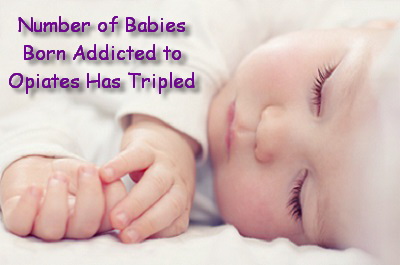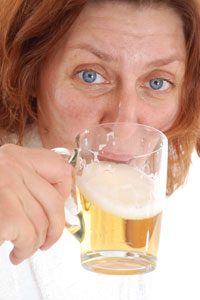You would be forgiven for thinking that the prescription drug epidemic affects only the users themselves. Abusing medicines such as Vicodin and OxyContin—opiate drugs with chemical similarities to heroin—puts the users at significant risk, killing more Americans than heroin and cocaine combined in 2008; but using when you’re pregnant presents a whole new class of risks. Babies of opiate-using mothers can be born in withdrawal, their systems shocked by the abrupt withdrawal of substances, and research has revealed that this is happening more and more frequently in the United States. In fact, three times as many babies were born with neonatal abstinence syndrome (NAS) in 2009 than in 2000, reflecting the rapid rise in the prescription drug problem.
The Study
Lead researcher Dr. Stephen Patrick had noticed an increase in the number of babies with NAS at CS Mott Children’s Hospital at the University of Michigan, and set out to determine whether the numbers were also increasing across the country. The researchers looked at discharge records from 2000, 2003, 2006 and 2009 from a database of patients that covers 44 states and over 4,100 hospitals. When the researchers determined which of the births were associated with opiate use, they revealed some shocking statistics about the extent of the problem.

They found that the number of pregnant women abusing opiate medicines when the baby was being delivered was five times higher in 2009 than in 2000. In addition, the researchers found that the rates of illicit drug use during pregnancy were 16.2 percent of teens and 7.4 percent of adults. Generally speaking—and somewhat obviously—any drug use during pregnancy poses some risk to the infant since they’re getting small doses of anything the mother takes.
As you might expect with the increase in numbers of opiate-using mothers, the number of babies born with NAS has also increased significantly. The rate almost tripled over the experimental period, from 1.20 per 1,000 births up to 3.39 in 2009. This has a disturbing parallel with the numbers of overdose deaths from prescription painkillers since the 1990s, which has also increased three-fold. The problem can’t exist in a vacuum—related issues, like babies born with NAS, are bound to increase as well.
What Is NAS?
NAS is a condition that occurs when the baby becomes addicted to drugs along with the mother when it’s in the womb. It isn’t just opiate drugs that can lead to it: marijuana, benzodiazepines, cocaine, amphetamines and the use other substances can also result in NAS. The symptoms include excessive or high-pitched crying, fever, irritability, tremors, sweating, sleep problems and sneezing or a stuffy nose.
The researchers also found that the babies born with NAS were over three times more likely to have respiratory problems and over twice as likely to have a low birth weight. Interestingly, they were also notably more likely to be covered by Medicaid, meaning that the issues were more common in low-income families.
Better Treatment or Prevention?
The researchers also looked at the average length of stay for the newborns with NAS, which they noted hasn’t decreased over the last decade. From their perspective, this represents an area in need of improvement for physicians. Since state Medicaid programs bear much of the brunt of the problem, there is a lot of motivation to improve care for opiate-addicted pregnant women. The researchers argue that since there are no standardized clinical guidelines for treatment of NAS, it is possible to improve care for the babies themselves, possibly using a combination of an opiate and another medicine such as clonidine, but breastfeeding can also help.
The other suggestion is to enroll opiate-addicted mothers in methadone programs or provide them with drugs such as buprenorphine, which is often used in cases of opiate addiction. If these interventions were successful, the numbers of babies born with NAS would decrease, rather than just the amount of time they have to spend in treatment as a result of it.
Clearly, prevention of NAS is a considerably better solution than merely determining a better way to treat babies suffering from it, but the problem impacts much more than pregnant women. The rates of prescription painkiller abuse across the U.S. are on the rise, so this research serves as yet another reason to address that problem.
Amelia liked to think of herself as a survivor—soft but strong, able to persevere. Raised by a mother with mental illness, she knew a lot about how to handle difficult people and delicate events; it seemed she’d been walking on eggshells for as long as she could remember. Her father had left when she was 12 and the care and keeping of her mother, who only grew more unstable as a result, had fallen exclusively to Amelia. By the time she was 17, she was an expert on her mother’s medical records, how and when she needed to take her medication, and was working to support the two of them. She never made it to college. Maintaining a full-time job and the constant attention required in the care of her mother didn’t leave time for school.
As anxiety settled in throughout her 20’s and with the occasional “dark moods” that lasted months sometimes, Amelia found herself less and less capable of enduring not the physical hardship, but the psychological. Still, she wanted nothing to do with therapy; why should she spend upward of $100 an hour talking about herself? Life was just the way it was. When headaches started to overtake her, she finally saw a doctor.
Offering her full history to the small town general practitioner, Amelia was persuaded to provide a background. She discussed not only her unrelenting headaches but also the steady sense that things simply weren’t right—how she shook nervously and sweated. Her GP prescribed benzodiazepines to be used for acute episodes of anxiety and opiates for what he determined were migraines.
For a while, Amelia found comfort in the hypnotic quality of the drugs. It was as if she were floating somewhere just outside herself and nothing could harm her there. As weeks and months wore on, however, Amelia discovered that the recommended dosage no longer treated her anxiety or her pain. She began to increase her dosage. When she was threatened with eviction after one of her mother’s “incidents”—she’d taken after the neighbor with a garden hoe—it all became too much. Amelia made it through the experience relatively unscathed, but she’d discovered something useful to her: her medications were more powerful when combined with wine.
It wasn’t until a friend noticed how much Amelia was taking that she questioned it herself. She realized she’d been relying exclusively on the medication and the sense of escape it gave her, taking it every four hours whether she needed to or not. But when she tried to quit she discovered something even more alarming—she couldn’t.
Gendered Differences in Addiction
The CDC reports that between 1999 and 2010, opioid overdose deaths among women increased fivefold, while the numbers for men increased three times. Since 2007, more women have died from prescription overdose than in car accident related injuries, cervical cancer or homicides. Further studies reveal that while women tend to become addicted later than men, they do so more quickly. Once addicted, women are more vulnerable to relapse, and are less likely to seek treatment than men. According to Constance Scharff, Ph.D., “Women most often use drugs to deal with stress and regulate moods.” Women are prescribed potentially addictive medications more often than men, and for longer periods. This may be because women are speaking more openly with their doctors about both physical and psychological complaints, but the reasons are not entirely understood.
Prescription drug dependence may go unnoticed even to the user—many believe that because the medications are prescribed, they are safe. When more than the recommended dosage is being used and for longer than is required and when symptoms of withdrawal (such as nausea, agitation and sleep disturbance) occur at the cessation of the medication, addiction should be considered.
High-Risk Group
Recovery from prescription drug dependence is as important as any other addictive substance or process. The White House considers women to be among the top three high-risk groups for addiction, and looking at the numbers for accidental overdose deaths, it is no wonder. Long term abuse of certain addictive prescription medications, such as the benzodiazepines, carry potential consequences: “over sedation, impairment of memory, balance and learning, depression and emotional blunting.”
Treatment for Prescription Drug Addiction
Treatment for prescription drug addiction is similar to other treatments for addiction; it consists of a behavioral component wherein addicts learn to cope with life stress or physical pain without the use of medications, and where previous users are taught to become self-observant and proactive when cravings arise. There is evidence that psychotherapy in combination with NA group attendance, or another form of collective substance abuse support, can be effective in helping women recover. Given the high pressure lives that so many modern women contend with—where work outside the home is a foregone conclusion even while work inside the home does not diminish—the stress and pain that lead many down the slippery slope of secret addiction is unsurprising. What is most important is that women like Amelia find the help they need to recover—including doctors who better understand the risks of prescribing medications known to create dependence.
Daphne sat across the table from her husband and mouthed the words, “I hate you.” Then she painted a charming smile on her face and ordered a salad. She and Sam were out to dinner with his family, something they did only rarely because of what Sam’s mother referred to as “Daphne’s drinking problem.” What no one at the table knew was that Daphne had a gram of cocaine in her clutch and no plans to drink more than one cocktail. To everyone’s surprise, a single margarita is all she had that night.
For the next four weeks, Daphne’s behavior was erratic. She didn’t find herself sneaking bottles of wine or vodka, passed out on the sofa in front of the television or lying in the floor of their shared walk-in closet, crying her eyes out over every conceivable wrong done to her in the past. Instead, she was scarce, hardly ever at home. When he did see her, she was wild with energy and ideas, frenetic to dress and shower and be off again. Her already thin frame appeared unusually slight. It didn’t look as though Daphne had been eating, or really doing anything but moving, fast.
Then on a Sunday afternoon, just like it had started, Daphne was suddenly home again—collapsed on the lawn, so drunk Sam could nearly smell the alcohol from the front door. Ever the co-dependent faithful partner, he walked to his wife and bent to scoop her into his arms. And just like clockwork, Daphne began to slur a litany of praise for her husband, how she could not live without him, how he was perfect in every way.
Days into Daphne’s return, however, she was threatening to stab herself with a kitchen knife if Sam didn’t give her access to all of her pain medication. Daphne received prescription opiates for a cracked cervical vertebra, and Sam sometimes hid them when Daphne’s drinking binges got especially bad. When she took the knife and started carving shallow cuts into the inside of her arm—something Daphne had done many times before, but always in private—Sam knew it was time to do what he had not yet done. He had his wife involuntarily hospitalized. An emergency hospital stay turned into a longer, voluntary in-patient psychiatric stay, and it was there that Daphne was formally diagnosed.
She was an alcoholic. She was a drug addict. She had anorexia. She had bipolar disorder. And she had borderline personality disorder. No one had expected this outcome, least of all Daphne.
Mental Disorders and Addiction
When a person has both a problem with addiction and a mental disorder, he or she is said to have a dual diagnosis (or comorbidity). Many times, substance abuse can mask the signs of mental illness. Traits or characteristics of mental illness, which may otherwise be quite noticeable to close family members and loved ones, cloak themselves in the depressed behavior brought on by excessive alcohol use (alcohol is itself a depressant), or the erratic behavior others exhibit whether using alcohol excessively or when high or seeking drugs.
People with certain mental disorders may seek to “self-medicate” the anxiety or depression that arises as a result of the disorder by consuming alcohol or using drugs, or a combination. One such disorder is bipolar disorder. About 56 percent of people with bipolar have experienced drug or alcohol addiction. The personality disorders, such as borderline personality disorder (BPD), also share a high rate of dual diagnosis. According to the Center for Drug and Alcohol Programs at the Medical University of South Carolina, “Over 50 percent of drug abusers and almost 40 percent of alcoholics have at least one serious mental illness.”
Besides bipolar and BPD, depression, anxiety disorders, schizophrenia and other personality disorders frequently co-occur with substance abuse. Psychiatric issues can begin before or after the onset of substance abuse.
Treatment for the Dual Diagnosed
There is no question that adding disorders and substance issues to the mix significantly compounds an individual’s stress and further complicates treatment options. Those who have co-occurring mental disorders have a higher rate of relapse when it comes to getting sober. But even people with mental disorders and co-occurring substance abuse issues can begin to heal. What helps is an integrated therapeutic approach—where mental health treatment and addiction recovery are not thought of as separate, but fused into an integrated whole. Compartmentalizing too many areas of her life is often how an addict with mental health issues gets to the place in which she desperately needs recovery, so seeing her life as a working whole is important.
Thinking, “I cannot attend to my sobriety if I do not attend to my bipolar disorder” and vice versa is a good way to think about it. It’s quite true, in fact—not simply a bromide offered by practiced faces in the business of therapy.
While Daphne’s situation may seem extreme, it is likely that the deeper part of her issues are connected. When she begins to do the work to unravel what the deeply held beliefs and long-held stories that most affect her mental state are, she may begin to find herself experiencing better balance—and an ability to deal with the boat-rocking experience of finding herself with a half-dozen labels, all too frightening to think about in the beginning.
Becoming educated about the nature of addiction and the reality of mental illness is a good place to start. Choosing to look at one’s life carefully is the opposite of what addiction means. When you wrestle the hydra of addiction and mental illness, you know you’re only going to get more of the same. Better not to go in swinging but with clarity, a willingness to learn and possibly, maybe, a little bit of room for something like hope.
06 Mar 2013
Alcoholism’s Effects in Women
Alcoholism is the classic term for patterns of alcohol abuse that result from a chemical dependence on alcohol’s presence in the body. Along with other abusive patterns of alcohol use, it belongs to a group of conditions known as alcohol use disorders (AUDs). Both men and women can develop a number of serious short- and long-term health complications as a consequence of alcoholism. However, while men become alcoholics more frequently than women, women alcoholics have higher risks than men for developing certain alcoholism-related health problems. In addition, female alcoholics die prematurely much more frequently than male alcoholics.
 The Basics
The Basics
For any given level of intake, women have a greater sensitivity to alcohol’s effects than men. Three physical factors help explain this phenomenon. First, relative to overall size and weight, women’s bodies contain less water than men’s bodies. This is relevant because water dilutes alcohol; therefore, in an environment that contains relatively little water, alcohol remain relatively undiluted and produces intensified effects. Second, compared to men’s bodies, women’s bodies apparently have less active forms of an enzyme called alcohol dehydrogenase, which plays a key role in breaking alcohol down and rendering it harmless; in real-world terms, reduced alcohol dehydrogenase activity translates into higher levels of alcohol lingering in the bloodstream. In addition, some women may be more susceptible to alcohol’s effects during certain phases of their menstrual cycles.
Because of their relative susceptibility to alcohol’s effects, women have a lower recommended maximum daily/weekly alcohol intake than men, the National Institute on Alcohol Abuse and Alcoholism explains. On any given day, the average woman can safely drink as much as a single drink of beer, wine, or hard liquor (the specific size of a standard drink varies according to the type of alcohol under consideration). In any given week, the average woman can safely consume as many as seven total drinks. By comparison, the average man under the age of 65 can safely consume two drinks a day and 14 drinks per week. For a variety of reasons not directly related to alcoholism, men over the age of 65 need to follow the same alcohol consumption guidelines as women.
The Consequences of Alcoholism
As indicated previously, women abuse alcohol and/or develop alcoholism less frequently than men. In fact, women account for only roughly one-third of all of the alcoholics in the United States. However, female alcoholics sometimes experience more severely negative health outcomes than male alcoholics. For instance, according to the Centers for Disease Control and Prevention, alcoholic women have higher chances of developing cirrhosis (scarring of the liver) and other alcohol-related liver disorders than their male counterparts. Compared to alcoholic men, alcoholic women also have higher risks for the onset of damage in the tissues that form the heart muscle; these heightened risks extend to women who abuse alcohol but don’t have all of the hallmarks of alcoholism. In addition, current research suggests that women alcoholics have relatively high chances of developing alcohol-related memory problems and physical shrinkage of their overall brain size. Women also apparently develop these problems more quickly than men.
In comparison to other women, women alcoholics have relatively high chances of developing certain forms of cancer, including cancers of the breast, colon, throat, liver, mouth, and esophagus. In the case of breast cancer, alcoholic women’s risks go up as their rate of alcohol consumption increases. Apart from disease-related risks, alcoholic women have increased risks for exposure to rape and other forms of sexual assault. These assault-related risks extend to women who participate in a form of alcohol abuse called binge drinking, which involves consuming enough alcohol within a two-hour timeframe to become legally intoxicated; most women reach a legally intoxicated state (marked by a blood alcohol content equal to or in excess of 0.08 percent) when they consume four or more drinks within this span of time.
Fatal Consequences
When considered together, men and women alcoholics between the ages of 18 and 64 die an average of 20 years sooner than people without alcohol dependencies, according to the result of a 14-year study published in published in 2012 in the journal Alcoholism: Clinical & Experimental Research. However, when the two genders are considered separately, women alcoholics in this age range die twice as often as alcoholic men. Compared to the general population, alcoholic women between the ages of 18 and 64 die more than four times as frequently. The authors of the study note that their results may somewhat overestimate women alcoholics’ risks for fatal outcomes, but believe any overestimation (if it exists) is in terms of specific percentages rather than the basic results of their research.
05 Feb 2013
Superwoman Syndrome and the Abuse of Adderall
 For many years women have been told that they can have it all and, believing that is true, have been busy doing what it takes to try and do just that. What women aren’t told as often is that once you have it all, you have to keep up with it all. This frenetic drive to have it all and keep it all going is sometimes referred to as Superwoman Syndrome.
For many years women have been told that they can have it all and, believing that is true, have been busy doing what it takes to try and do just that. What women aren’t told as often is that once you have it all, you have to keep up with it all. This frenetic drive to have it all and keep it all going is sometimes referred to as Superwoman Syndrome.
Read More
Expectant mothers are recommended to completely avoid alcohol during pregnancy. While new information is regularly gained by ongoing research, it has long been understood that alcohol certainly provides no benefit to the fetus. Instead, the use of alcohol during pregnancy has been linked to major cognitive and physical development problems.
Read More
Over the counter medicines and prescription drugs have played an important role in American women’s lives since the revolution in the 60s. The so-called “Mother’s Little Helper” pill was first known as Valium in the 60s and 70s and went through a variety of pill changes to the current anti-depressant Prozac.
Read More
03 Apr 2012
Inviting Women to Drug Rehab
According to the Federal Center for Substance Abuse Prevention, nearly 2.7 million women in the U.S. abuse alcohol or drugs. However, only about 25 percent of patients in drug rehab programs are women.



